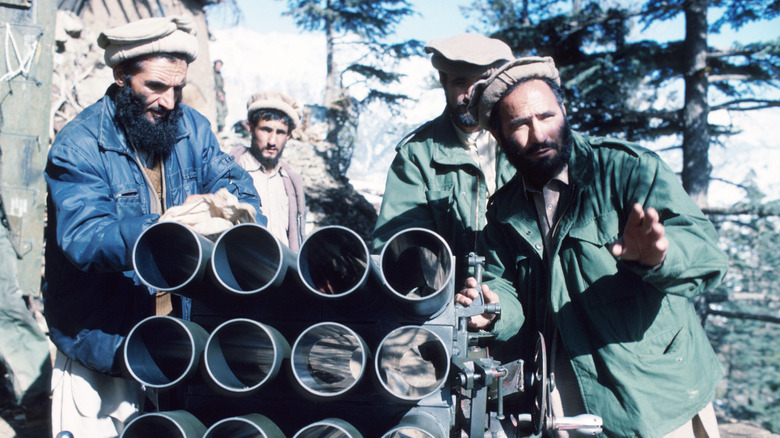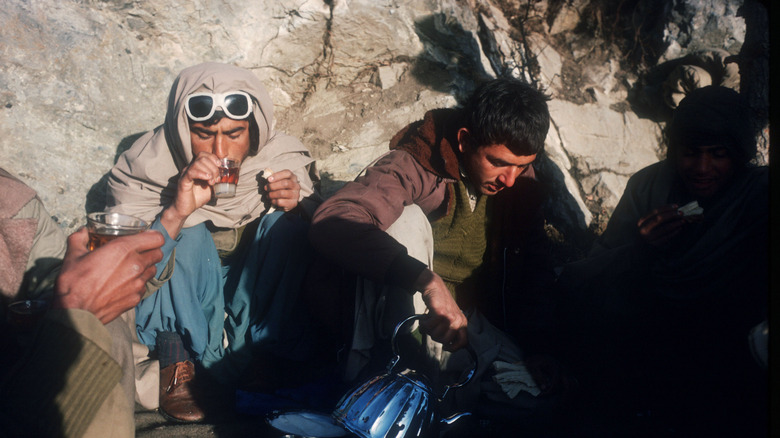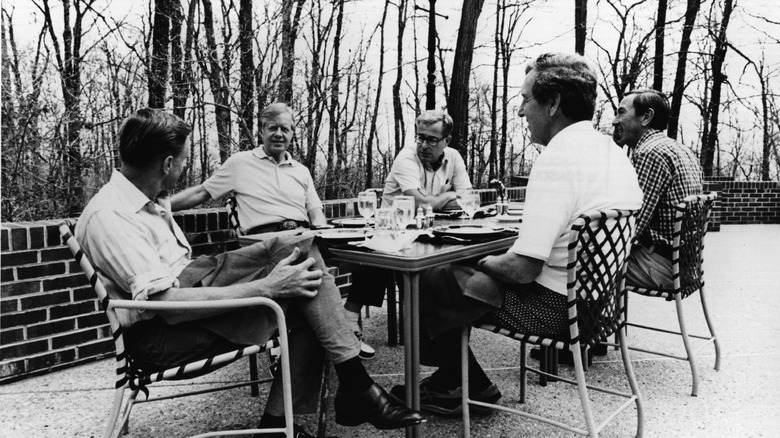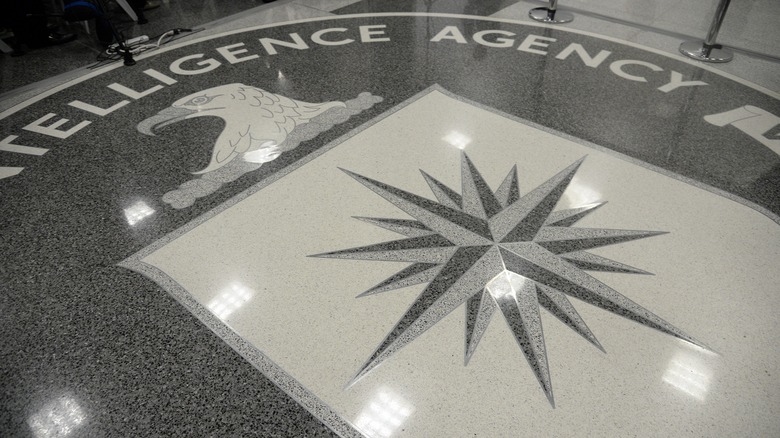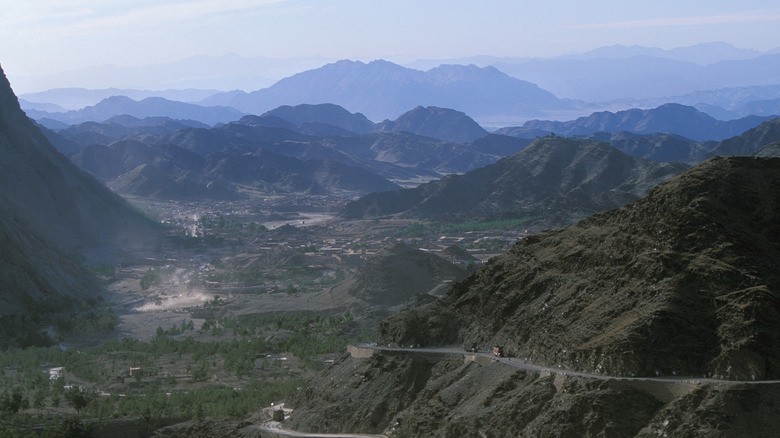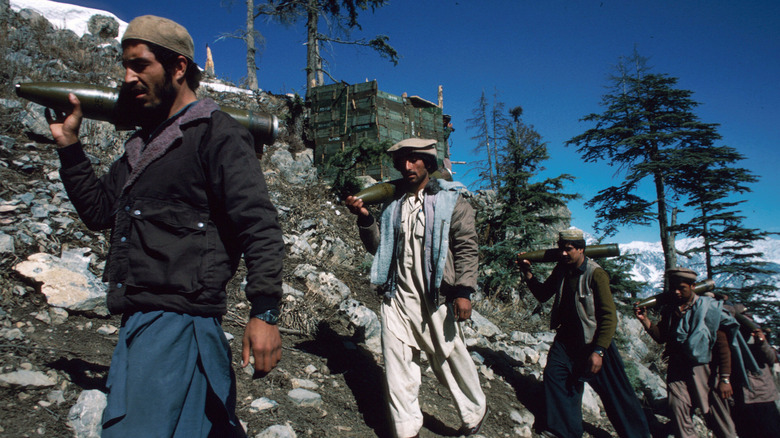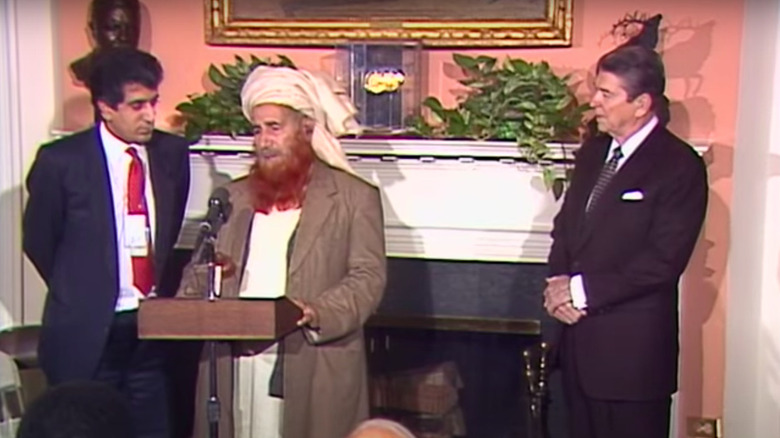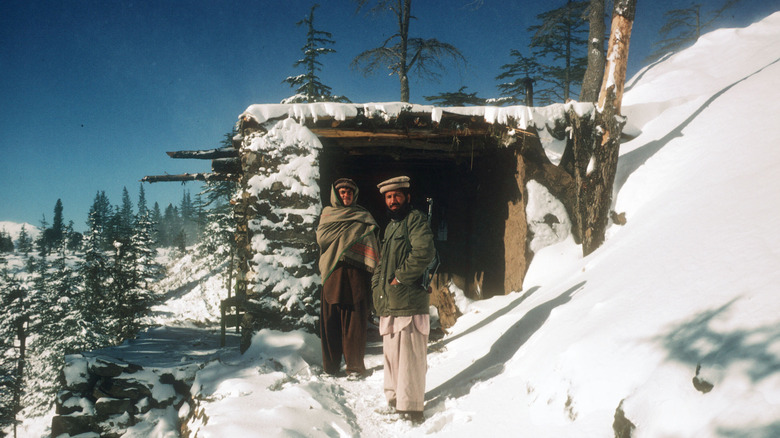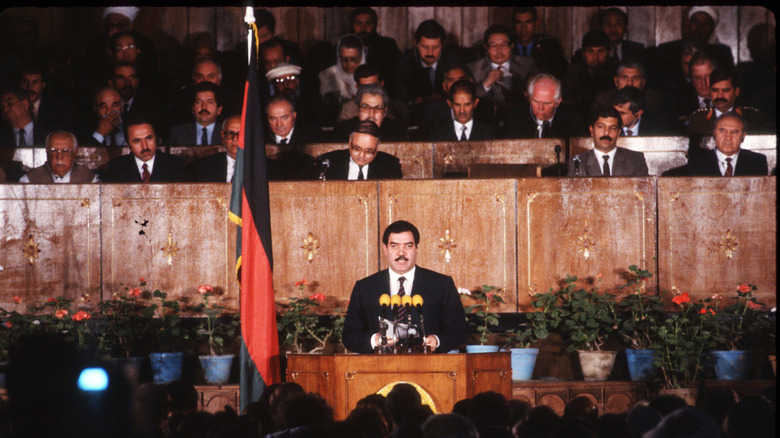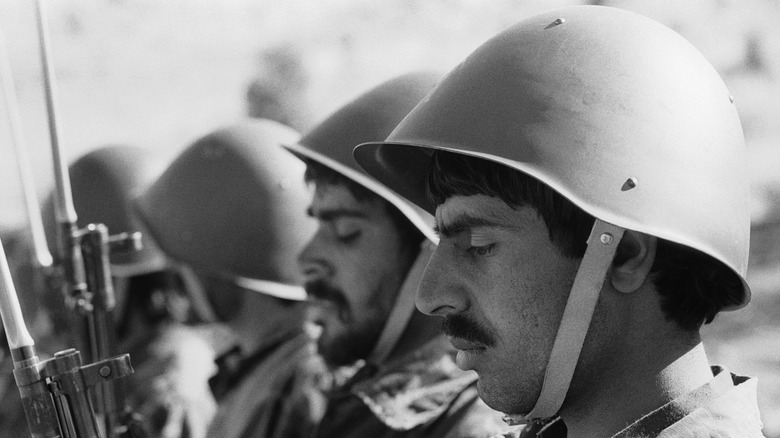What Really Happened In Operation Cyclone?
Those who seek to defend the CIA and the United States government's involvement in Afghanistan during the 1980s are often quick to point out that the United States was never directly involved in training the mujahideen, claiming that therefore no responsibility is borne for the creation of the Taliban. However, this understanding disregards the billions of dollars in money and weapons that the United States, along with several other countries, poured into the mujahideen cause. And they did so without any long-term considerations and with no regard for the fragmentation that it caused amongst the Afghan people.
To say that the United States bears no responsibility is to get off on a technicality, but to say that the United States directly funded the Taliban is also widely inaccurate. Instead, the project known as Operation Cyclone created an environment where money and weapons were freely flowing, mostly into the hands of those whom foreign powers knew were working in their favor. And the United States wasn't alone in this. Pakistan arguably played the biggest part in Operation Cyclone while the United States and Saudi Arabia provided the cash. And at this point, the Taliban didn't even exist yet. All this was done towards defeating the spread of Soviet influence. Whether or not Operation Cyclone was instrumental towards this is debatable, but what is left behind is far from uncertain. Here's what really happened in Operation Cyclone.
Who were the mujahideen?
The mujahideen were members of guerrilla groups that were rebelling against the People's Democratic Party of Afghanistan's (PDPA) rule in the Democratic Republic of Afghanistan (DRA) and later the Soviet army in the late 1970s. Their name can be translated as "one who undertakes jihad," and while this struggle was against the Soviet-backed government, the mujahideen were "far from monolithic." Made up of various factions of leftist internationalists, Islamic universalists, and Afghan nationalists, some of which were more fundamentalist than others, the groups were comparable only by their anti-government stance, Mohammad Hassan Kakar writes in "Afghanistan." Otherwise, there was little uniting these various groups in their fight against the Soviet-backed DRA.
Initially, most of the mujahideen were native Afghans, but after the Soviet invasion, Operation Cyclone allowed for numerous foreign mujahideen to be brought in as well. But the United States was involved in funding the mujahideen well before the Soviet army actually invaded Afghanistan. According to The Conversation, by July 1979, the United States was already providing "advice and nonlethal supplies" to the mujahideen. After President Jimmy Carter was encouraged to respond more aggressively after the Soviet army invaded, the CIA started organizing deliveries of weapons to the mujahideen as well.
The mujahideen that ended up being primarily funded by Operation Cyclone included the faction led by Saudi-backed Abdul Rasul Sayyaf, as well as Gulbuddin Hekmatyar and his militia.
What was the goal of Operation Cyclone?
Although the main goal of Operation Cyclone was to fund the mujahideen against the Soviet-backed DRA, it was also intended to destabilize the influence of the Soviet Union in Central Asia. In a 1998 interview with Le Nouvel Observateur, Zbigniew Brzezinski, President Carter's National Security Adviser, admitted that he wrote to the president when the Soviets crossed the border, stating "We now have the opportunity of giving to the USSR its Vietnam war."
According to a now-declassified memorandum, Brzezinski still noted to President Carter the differences between the situation in Afghanistan and the situation in Vietnam. Nevertheless, he stated that it was essential to continue backing the mujahideen, which meant "more money as well as arms shipments to the rebels, and some technical advice." Brzezinski also noted that the assistance of Pakistan would be necessary, and that the United States "should concert with Islamic countries both in a propaganda campaign and in a covert action campaign to help the rebels." In an interview with Democracy Now!, journalist Steve Coll states that Operation Cyclone was initially intended to simply "harass Soviet occupation forces [but] eventually they embraced the goal of driving them out."
Brzezinski also proposed going to the United Nations and claiming that the actions of the Soviets were "a threat to peace." But at the end of the day, Operation Cyclone wasn't concerned with peace or the self-determination of the Afghan people. It was about catching the Soviets in "the Afghan trap."
Who was involved in Operation Cyclone?
Operation was mainly composed of a three-way alliance between the United States, Pakistan, and Saudi Arabia. According to Democracy Now!, the United States provided money as well as technological and logistical support. Saudi Arabia would write a matching check "dollar-for-dollar" and would collaborate with Inter-Services Intelligence (ISI), Pakistan's intelligence service. In addition to being the main channel for U.S. and Saudi assistance, Pakistan was also involved in training fighters, opening borders, and "mobiliz[ing] Pakistanis for jihad," Muhammad Haniff Hassan writes in "Mobilization of Muslims for Jihad: Insights from the Past and their Relevance Today."
In "Why Paramilitary Operations Fail," Armin Krishnan notes that the United States government gave Pakistan "extensive control over [the] specifics" of Operation Cyclone. And although American money was accepted, as was ammunition and equipment, it was reportedly "a cardinal rule of Pakistan's policy that no Americans ever become involved with the distribution of funds or arms once they arrived in the country."
But it wasn't just those three countries that were involved. In "The Other Side of the Mountain," Ali Ahmad Jalali and Lester W. Grau write that throughout Operation Cyclone, the United States, France, Great Britain, Italy, China, Saudi Arabia, and the United Arab Emirates all played a part in giving money to the mujahideen.
How much did Operation Cyclone cost?
Operation Cyclone is listed in the Guinness Book of World Records for being "the most expensive [known] covert action" and is believed to have cost the CIA $2 billion between 1979 and 1989. But this is still one of the lower estimates. In "US-Pakistan Relationship," A.Z. Hilali writes that the United States and Saudi Arabia gave up to $3.5 billion to the mujahideen, each if Saudi Arabia was matching U.S. aid, and 65,000 tons of weapons were also delivered to the ISI for the mujahideen.
Overall, it's known that the United States was spending between $15-30 million per year in the beginning and by the end it was as high as $600 million a year, per Counter Terrorist Trends and Analyses, so it's possible that several billions worth of money and weapons were funneled to the mujahideen. Various other resources were given, such as mules from Tennessee, which were transported to Pakistan in order to carry equipment, medical supplies, and food from Pakistan into Afghanistan. In one year alone, up to 700 mules were shipped to Pakistan from Tennessee.
But according to The New York Times, it's unclear exactly how much Congress would appropriate for the mujahideen because "the operation [was] not officially acknowledged by Washington." However, Operation Cyclone still had strong bipartisan support in the United States government.
Money, money, money
As one of the other main points of the Washington-Riyadh-Islamabad triangle, Saudi Arabia supported the mujahideen with funding and coordination with the ISI. According to journalist Ahmed Rashid, one estimate claims that Saudi Arabia provided up to $4 billion in aid to the mujahideen, not including "unofficial aid from Islamic foundations, charities, private funds of Princes, and mosque collections." In addition, Saudi Arabia was also offering things like subsidized flights to Afghanistan for young men who were willing to join the mujahideen in their fight against the Soviets, writes Ali Soufan in "Anatomy of Terror."
And according to Exploring Iran and Saudi Arabia's Interests in Afghanistan and Pakistan by Dr. Guido Steinberg and Nils Woermer, Saudi Arabia also "built its own contacts and client networks" among the mujahideen and its involvement didn't end with Soviet withdrawal. However, by the 1990s Saudi involvement was reportedly scaled back and followed Pakistan in their support of the Taliban.
In "US-Pakistan Relationship," A.Z. Hilali also writes that Rabitat al-Alam al-Islami (Muslim World League), a Saudi-based and funded organization, collaborated closely with Jamaat-e-Islami, an Islamist political party in Pakistan, and was responsible for "distribut[ing] millions of dollars among Afghan groups."
Pakistan's role
The tensions between Afghanistan and Pakistan started with the Durand Line, which the British established in 1893, dividing Pashtun people between Afghanistan and Pakistan. However, tensions around the territory started to flare up in 1973, when Pakistani Prime Minister Zulfiqar Ali Bhutto started a training facility to resolve the "unsettled issue of Pashtunistan with Afghanistan and Kashmir with India," Mir Hekmatullah Sadat writes in "The CIA Operation Cyclone's Blowback."
After General Muhammad Zia-ul-Haq declared martial law and took over Pakistan in 1977, more camps were established across Pakistan in addition to the ones created by Bhutto in Kohat, Bannu, and Waziristan. Overall, there were at least 113 mujahideen training camps in Pakistan. And while it's difficult to confirm an exact number, it's estimated that up to half a million mujahideen were training in Pakistani training camps, per "US-Pakistan Relationship." Democracy Now! writes that the Pakistani army was responsible to deciding which mujahideen factions to favor, and they were the ones who decided to channel most of the funding towards seven radical Islamist factions. And this was done largely because it "suited the Pakistan's army [sic] goal of pacifying Afghanistan."
Most of the money and equipment from the United States and Saudi Arabia was funneled to Hekmatyar, who had even signed a paper confirming that the Durand Line would be respected if he gained power in Afghanistan.
Recruiting foreign volunteers across the Islamic world
The training camps were used to train thousands of men who came from various countries to join the Afghan mujahideen. In "Bin Laden," Yossef Bodansky writes between 16,000 and 20,000 people came from up to 20 countries to be trained in Pakistan in the late 1980s alone. While a majority came from Arab countries, many came from the Philippines, Malaysia, and Yugoslavia as well.
Saudi Arabia also mobilized its global Wahhabi network towards recruitment, per "The Neoliberal Landscape and the Rise of Islamist Capital in Turkey." In doing so, the Soviet Union was depicted as the ultimate enemy and Muslim men from around the world were encouraged to join the fight.
According to E-International Relations, this was how Osama Bin Laden got involved with the mujahideen. Initially, he was working in a type of recruitment halfway house, offering basic military training and fundraising. Eventually, Bin Laden went to Pakistan where he and Abdullah Azzam created Maktab al-Khidamat, or the Afghan Services Bureau, which was used to recruit and raise funds for foreign mujahideen. At most, this organization funneled $600 million to the mujahideen.
President Reagan offers his full support
Under the Reagan administration, more and more money was allocated to Operation Cyclone and in 1983, President Ronald Reagan went even further and secured a photo op with some of the mujahideen. In February 1985, President Reagan met with seven mujahideen, calling them "freedom fighters," and while it's unclear if the seven mujahideen were the leaders of the seven factions supported by Pakistan, it's likely that they were the ones the White House sought to embolden. In 1987, President Reagan also met with one of the mujahideen leaders, Yunis Khalis.
However, as USA Today notes, the image of Reagan with the mujahideen is frequently circulated with the false information that Reagan is sitting with the Taliban and has compared them to the Founding Fathers. The Taliban emerged in 1994, well after the picture was taken, and the comparison to the Founding Fathers was actually a statement that Reagan made about the Contras in Nicaragua, rather than the mujahideen.
And despite the fact that the United States has historically sought to suppress global drug use, in "A Concise History of Afghanistan in 25 Volumes, Vol 1," Hamid Wahed Alikuzai writes that the Reagan administration was tolerant of mujahideen like Hekmatyar who used "opium production as a source of income." And there was no oversight for the huge amount of weapons that both the Carter and Reagan administration shipped to the mujahideen, ultimately leading to a "thriving and uncontrollable world weapons market."
Blurring the line between media and propaganda
Although the United States wanted Afghanistan to be the Soviet Union's Vietnam, one of the many critical differences between the two engagements was that there were drastically fewer foreign correspondents in Afghanistan. According to Journalism as Jihad in Afghanistan by Marya Hannun, while the Vietnam war saw hundreds of American and European reporters, in Afghanistan there were no more than a dozen at the height of the conflict.
In response, the United States Information Agency established the Afghan media Resource Center in 1987. "Like much of the USIA's work, the initiative straddled the delicate and often blurry line between media and propaganda." A grant of $500,000 was approved by Congress and was awarded to Boston University's College of Communications for the program. And Bernard S. Redmont, who was dean at the time, ended up resigning when the USIA announced that the training would take place in Pakistan, rather than on campus, The New York Times reports.
The footage gathered by the journalists traveling with the mujahideen was sent to global syndication services, and although it was technically banned from being shown in the United States, since the Smith-Mundt Act bans government-funded media from being broadcast, some of the news stories found their way onto American mainstream media. The project was funded until 1992 and the USIA was dissolved in 1999, but between 1987 and 2012, the AMRC continued producing footage, creating over 3,000 hours of videotape and 500 hours of audio recordings.
America starts to siphon off its aid
As the Soviet Union signaled their withdrawal from Afghanistan in 1989, the United States felt like their mission was accomplished and the communist threat was contained. But that didn't necessarily mean that they were necessarily going to immediately stop funding the rebel groups. According to "A Concise History of Afghanistan in 25 Volumes, Vol 1," the United States paid out over $4 billion to Pakistan between 1987 and 1991, in addition to $600 million for Afghan refugees on Pakistan's border. But with President Mohammad Najibullah's government about to fall, Congress allocated just $280 million to Afghanistan in 1990.
At the end of the day, the funds weren't flowing into the mujahideen as freely as they once were. William Maley notes in "The Afghanistan Wars" that the Bush administration didn't deliberately abandon the mujahideen, but "certain glitches in the early days of the Bush Administration left the Mujahideen under-resourced" at a critical moment.
The fact that Soviet expansionism was no longer an issue was part of the shift in America's disinterest, coupled with the fall of the Soviet Union in 1991, but Iraq's invasion of Kuwait in 1990 was the biggest distraction. In the end, Operation Cyclone was finally terminated in 1992. One of the last transfers to the mujahideen was in June 1991, when the Bush administration approved a transfer of $30 million in captured Iraqi weapons "off-budget."
Afghanistan falls into a civil war
After the Soviet army left Afghanistan, the mujahideen continued fighting the Republic of Afghanistan in what is considered to be the first part of the Afghan Civil War. The mujahideen, aligned under the Seven Party Alliance, eventually wrestled control away from the government of the Republic of Afghanistan and in April 1992, Kabul fell to the mujahideen, per Dalhousie University, and the mujahideen established the Islamic State of Afghanistan. However, due to infighting and an inability to "maintain power sharing arrangements," the mujahideen were unable to maintain control of Afghanistan.
The infighting would continue as various factions were supported by different foreign countries, like Saudi Arabia or Pakistan. As a result of the infighting, the Taliban were able to take over Kabul in September 1996 and establish the Islamic Emirate of Afghanistan. However, throughout their reign they were never able to get control of the north.
Founded by Mullah Mohammad Omar, a Pashtun mujahideen commander, in 1994, the Taliban was made up of both the mujahideen as well as young Afghans who had grown up in refugee camps after fleeing persecution and warfare, according to The Conversation. Although the Taliban didn't start the historical persecutions of the Hazara people, they took it up with numerous massacres, reports The Guardian. One of the deadliest massacres occurred in August 1998, when up to 2,000 Hazara were executed in what was described as a "killing frenzy."
